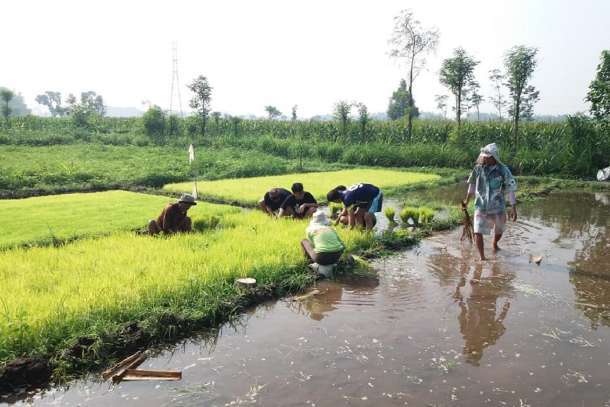It began in 2005 when Vincentian Father Marcelinus Hardo Iswanto was appointed by the Congregation of the Mission’s provincial superior to be responsible for the leadership and welfare of St. Joseph Parish in Kediri, East Java province.
Oct 13, 2021

By Katharina Reny Lestari
It began in 2005 when Vincentian Father Marcelinus Hardo Iswanto was appointed by the Congregation of the Mission’s provincial superior to be responsible for the leadership and welfare of St. Joseph Parish in Kediri, East Java province.
“For about the first two years, I thought of adding pastoral values related to the life of people, mostly those living in villages, to the parish. The issues of global warming and climate change came to the surface at that time, so I thought that I could start doing something about environmental protection,” he says.
The 53-year-old priest, who was ordained in 1996, later learned how to plant crops such as rice, corn, cassava, fruit and vegetables using a traditional agricultural method on a plot of land belonging to a parishioner in 2007.
Soon after that, he bought a hectare of agricultural land in Sambirejo, a village in Kediri district about 18 kilometers from his parish church.
“To buy the land, I had to borrow money from a cooperative of which I was a member. I paid it in installments,” he says.
Father Iswanto began to cultivate the land in 2008. He later built a community building called a rumah joglo (Javanese house with distinctive cone-shaped roof), where people could meet and discuss agricultural issues.
“I wanted to present the face of the Church to both Catholics and non-Catholics. This was also how I enlivened the spirit of my congregation,” he says.
That dream was in line with his congregation’s motto — evangelizare pauperibus misit me (proclaiming the Good News to the poor) — and specific purpose to preach missions to the poor, especially those living in rural areas.
“I was thinking that farmers were small people who live in villages. Unfortunately, people tended to see farmers as those with a simple and insignificant profession. None would be happy being a farmer,” he says.
“I was also seeing farmers as people who were very close to the environment. If I could give them an example of how to promote organic farming, I would see protectors of the environment some day.”
Gubug Lazaris
Father Iswanto was later able to buy two more hectares of land next to the existing plot. In August 2010, on the 14th anniversary of his priestly ordination, he officially named the area Gubug Lazaris.
Gubug refers to a small hut built and used as shelter by farmers while Lazaris refers to members of the Congregation of the Mission.
They are known as the Lazarists because of their former headquarters at the Priory of St. Lazare in Paris where the congregation moved to in 1632.
“I wanted Gubug Lazaris to become a place for villagers to learn eco-friendly agriculture and to promote organic farming,” he says.
With help from some villagers with adequate farming skills, he turned more than half of Gubug Lazaris — which was in bad condition due to poor farming methods used by previous landowners — into a rice field.
He used the rest to plant other crops as well as to build a shelter for livestock and a facility to produce organic fertilizer. In 2014, he also built a biogas production facility there.
“Now there are 20 cows. We have used their manure to make organic fertilizer and to produce biogas,” he says.
Biogas is a biofuel naturally produced from the decomposition of organic waste. When organic matter, such as food scraps and animal waste, break down in an anaerobic environment where oxygen is absent, they release a blend of gases, primarily methane and carbon dioxide.
Due to the high methane content in biogas, it is flammable, producing a deep blue flame that can be used as an energy source.
Four years later, with help from a friend, Father Iswanto installed 15 solar panels as an alternative energy source for Gubug Lazaris.
“One solar panel can produce 100 watts of power per day, meaning we can produce 1,500 watts. We have used this alternative source of energy to pump water from our wells so that we can water the land without paying for electricity provided by the state-owned electricity giant,” he says.
Study visits
Because of its eco-friendliness, many groups and individuals from different religious backgrounds have visited Gubug Lazaris to learn organic farming. Some spend a few hours there, while others spend one or two days.
“I usually take them on a tour of the place. This is eco-pastoral work and not so much about farming skills or organic agriculture. I always tell my guests whoever they are — children, university students, farmers, environmentalists or government officials — about the importance of protecting the environment,” Father Iswanto says.
Ari Purnomo Adi, a Muslim environmentalist from Wates, a nearby village, has visited Gubug Lazaris three times.
“As a religious leader, Father Iswanto has a complete understanding of how to protect the environment. He has holistic ecological repentance,” he says.
“He not only promotes organic agriculture but also instills into young people the need to protect the environment.”
Such an acknowledgment is not something the priest, who moved to Christ the King Church in the provincial capital of Surabaya early this month, should be attributed to him.
“I do not want to claim this as my achievement. As a priest, I must live up to my calling. Let us say this is an offering to my congregation and the Church. I hope other Vincentian priests can continue what I have started.”––ucanews.com